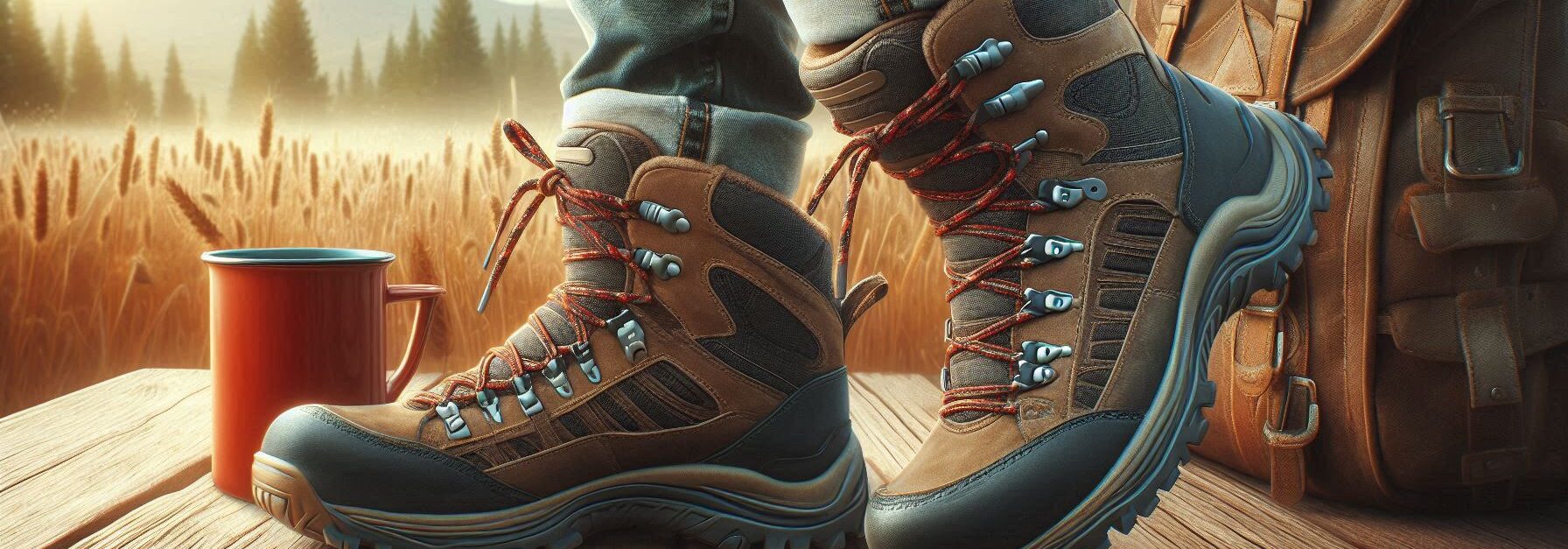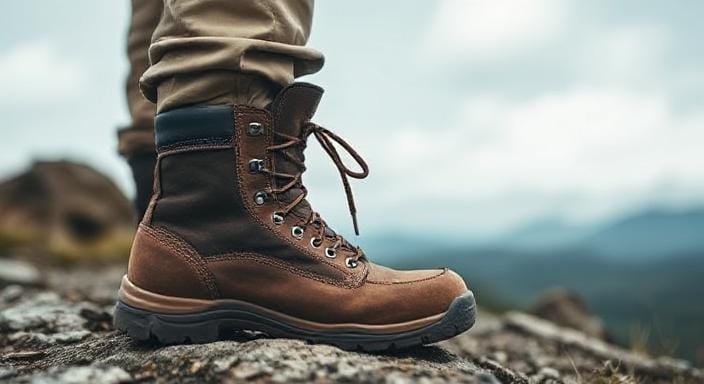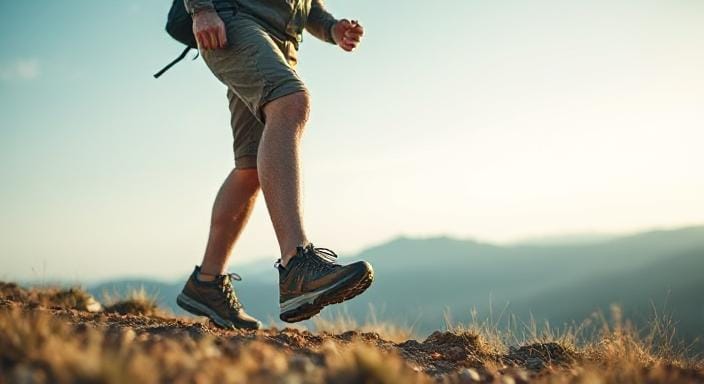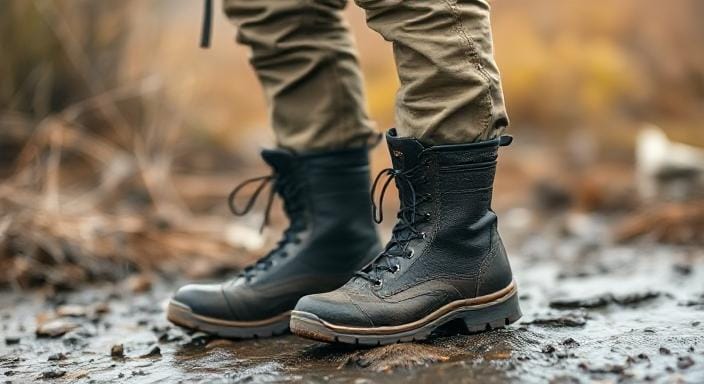Top Takeaways and Key Concepts
- Choose footwear based on terrain to avoid pain, slips, and ruined hikes.
- Wear waterproof boots in wet conditions to prevent blisters and cold, soggy feet.
- Use lightweight trail runners only for smooth trails and light hiking.
- Pick between breathable or waterproof shoes based on climate and trail moisture.
- Ensure a proper fit by testing shoes with hiking socks to prevent blisters.
Summary of This Article
Please Note: This post may contain affiliate links. If you click one of them, we may receive a commission at no extra cost to you. As an Amazon Associate, I earn from qualifying purchases.
This article explains why choosing the right footwear is essential for hiking comfort and safety. It highlights the benefits of sturdy hiking boots for ankle support and durability on rough trails, while lightweight trail runners are ideal for speed and comfort on smooth paths. The article also discusses choosing between waterproof and breathable materials based on weather conditions and terrain. It reminds hikers that fit matters most—shoes must be broken in and tested with proper socks to prevent blisters and pain. With the right shoes, hiking becomes enjoyable instead of painful.
Short Video Version of this Article
It’s really crucial to pick the correct shoes for a hike. You know, if you pick the wrong ones, it can ruin a fun day and make it hurt. You might wish you had stayed home instead of walking about in pain.

I recall this one time. I believed I was ready for an adventure. Everything felt great, and the sun was shining. But what about my shoes? Oh my, those were better for relaxing on the couch than for hiking up hills! My feet hurt so much that I had to limp back halfway through. Not the day I had planned!
Let’s talk about shoes and boots for hiking so you don’t end up like me. You should be able to wear good hiking shoes immediately away and they should fit properly. Also, make sure they have a solid grip! You want to feel safe while you walk on rocks or through mud.
If you’re going to be in rainy places, think about getting waterproof gear. When you’re trying to admire nature’s beauty, nothing is worse than having wet socks. And what about those soft soles? They’ll keep your feet from feeling like they’ve been through a blender after a lengthy walk.
Don’t rush when picking out shoes. Put on the socks you plan to wear with them. Before you go on that huge hike, walk about in them. This way, you’ll know they won’t let you down when you’re outside enjoying the fresh air and wonderful surroundings.
Hikers are delighted when their feet are happy! Before your next journey, let’s get those shoes in order!
The Classic Hiking Boot: Strong and Dependable

The first thing you need are basic hiking boots, which are tough enough to endure an apocalypse. If there is ever a zombie invasion while you’re out on the trail, you will want these nasty boys on your feet.
They support your ankles and make you feel like you have little guardians around them that keep them safe from twists and turns while you walk on uneven routes.
These boots are made of strong materials that can handle any kind of weather. A decent pair will keep your feet dry and comfortable, no matter if it’s raining, muddy, or even snowy (yes, winter treks are a thing!).
But here’s the catch: before you hit the trails, make sure to break them in! Trust me, blisters aren’t just a fashion statement; they’re a painful reminder that your boots need to spend some time with your feet first.
Their grip is another excellent thing about them. You know how it feels like an Olympic sport to walk on slippery surfaces? Well, hiking boots usually feature strong treads that cling rocks and dirt like they’re holding on to their last slice of pizza at a party. This means fewer falls and fewer awkward times when attempting to impress friends.
Lightweight Trail Runners: Fast and Comfortable

Now let’s talk about lightweight trail runners, the sleekest athletes in the shoe business! Trail runners might be your greatest buddy if you appreciate speed over stability (and who doesn’t adore feeling like a gazelle?). These sneakers are made for people who wish to be quick without giving up comfort.
Trail runners are super light and comfy. It’s like they’re saying, “Hey, don’t worry! We’ve got your back!” They’re perfect for short hikes or running on nice paths. You can feel the breeze on your feet while still getting some good cushioning.
These shoes work well when you want to move fast. If you’re zipping along a smooth trail, they can really help you feel quick and light on your feet. No heavy boots slowing you down!
But here’s the thing: trail runners don’t give as much support to your ankles as regular hiking boots do. If you’re planning to hike over rocky paths or carry a big backpack, it might be better to choose something sturdier.
Imagine stepping on a sharp rock with no ankle support—ouch! Not fun at all. So if you’re heading out for an adventure full of surprises, think twice about those trail runners unless you’re ready for anything that comes your way.
It’s all about knowing what type of hike you’re going on and choosing the right shoes for it. Your feet will thank you later! Happy hiking!
Finding the Right Balance Between Waterproof and Breathable

When deciding between waterproof and breathable shoes, think about where you’ll be walking the most. Are you walking through thick woodlands where puddles are often nearby? Or are you walking through parched deserts where being able to breathe is important?
Waterproof boots are wonderful for hiking in the rain because nothing ruins a journey faster than wet socks! Also, a lot of models include Gore-Tex linings that keep water out but let sweat escape, which is a great benefit.
Keep in mind, though, that waterproof doesn’t equal invincible. I learned the hard way that shoes that are immersed won’t work properly when they’re fully submerged (as I did when I crossed a creek).
Breathable shoes, on the other hand, are great for hot summer days when you start to feel like you’re toasting marshmallows over an open flame.
If you need to stay cool in hot weather or on lengthy excursions where you sweat a lot, breathable choices might be better.
Sandals and crampons are types of specialty footwear.
When it comes to different types of outdoor shoes, don’t forget about sandals and crampons! Yes, sandals have come a long way from being just casual beach gear. They are now serious options for some types of activities!
Hiking sandals let your feet breathe and provide you grip without completely covering them. They’re great for summer trips near water or on easy trails. Just remember to put sunscreen on your toes, because no one wants to have lobster-red feet ruining their fun!
But if you’re going to be on ice terrain that needs spikes, you’ll definitely require crampons properly linked to the right shoes instead. These clever gadgets turn any pair of boots into ice-climbing machines that can handle steep slopes that have been made smooth by frozen precipitation (or just show off!).
Size Matters: Picking the Right Fit
In the end, it’s all about finding the proper fit! A shoe that fits perfectly should feel snug but not tight, like wearing comfy pajamas instead of slim jeans after Thanksgiving dinner (we’ve all been there). To make sure you stay comfortable on long hikes:
1. Try it out before you buy it: Walk around inside first!
2. Wear the Right Socks: Bring pairs of socks that are about the same thickness as the ones you wear outside.
3. Look for Toe Room: Make sure there is room in the front so your toes don’t get squished.
4. Think about orthotics if you need extra support!
Finding shoes that fit just right is super important. It helps keep your feet happy and can stop you from getting hurt later on. Nobody wants to deal with sore feet or, worse, an injury that keeps you from having fun outdoors.
You probably already know how crucial it is to choose the right shoes for your adventures! There are so many options out there. You’ve got those sturdy hiking boots that hug your ankles and give you all the support you need. They’re like a warm hug for your feet when you’re climbing rocks or walking on tricky paths.
Then there are lightweight trail runners. They feel almost like wearing clouds on your feet! Perfect for quick movements and smooth trails. But they don’t always protect your ankles as much, so think about where you’ll be going.
In the end, it’s all about what feels good for you and what kind of adventure you’re planning. Do you want to stroll through a forest? Or maybe race down a flat path? Your choice will make a big difference in how much fun you have!
So take a moment, try on different shoes, and see what fits best. Your feet will thank you later! Happy exploring!
Frequently Asked Questions
What type of footwear is best for hiking?
The best footwear depends on the terrain. Hiking boots are ideal for rocky, uneven trails because they provide ankle support and stability, while lightweight trail runners work well on smooth or short trails where speed and comfort are more important.
Do I really need waterproof hiking boots?
Waterproof boots are great if you often hike in rainy areas, through wet grass, or near streams. They help keep your feet dry and prevent blisters, but they may feel warmer than breathable shoes in hot climates.
Are trail running shoes good for hiking?
Trail runners are a good choice for easy day hikes or well-maintained paths. They’re lightweight and comfortable but don’t offer much ankle support, so they aren’t the best option for rocky or steep trails.
How do I choose between waterproof and breathable shoes?
Choose waterproof shoes if you hike in wet or cold conditions. Pick breathable shoes if you hike in hot weather or sweat a lot—you’ll stay cooler and more comfortable over long distances.
Why do I need to break in hiking boots?
Breaking in your boots helps the material mold to your feet, preventing painful blisters and hot spots. Wear them around the house or on short walks before taking them on a long hike.
How should hiking shoes fit?
Hiking shoes should feel snug but not tight. You should have enough toe room to wiggle your toes, and your heel shouldn’t slip when you walk. Always try them on with the socks you plan to hike in.
Are sandals or crampons good for hiking?
Hiking sandals are great for warm weather and water trails, but they don’t offer much protection. Crampons, on the other hand, are essential for icy or snowy hikes and attach to boots for better traction and safety.
Suggested Resources:
Hiking Boots Buying Guide
https://www.rei.com/learn/expert-advice/hiking-boots.html
The Best Hiking Shoes Reviewed
https://www.outdoorgearlab.com/topics/clothing/best-hiking-shoes
How To Choose Hiking Boots
https://www.campsaver.com/blog/how-to-choose-hiking-boots/

Kevin Collier is a seasoned outdoor enthusiast and writer for Trekbug.com, specializing in outdoor adventures, survival strategies, and prepping insights. With a deep love for nature and a commitment to self-sufficiency, Kevin empowers readers to embrace the wilderness confidently. He shares valuable tips, practical techniques, and inspiring stories, helping both novice and experienced adventurers develop essential skills for surviving and thriving in the great outdoors.





